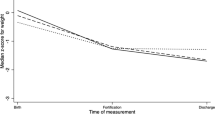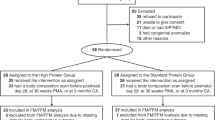Abstract
Objective
To evaluate the growth of premature infants fed a postdischarge diet of human milk (HM) complemented with transitional formula (TF) as compared with those fed TF only.
Study design
In this prospective cohort study, 51 infants’ diets and anthropometrics were collected at discharge and at 12–15 months corrected gestational age.
Results
Post discharge, infants in both groups exhibited similar growth velocities and changes in z-scores. The duration of infants’ HM consumption was not correlated with weight gain (r = −0.25, p = 0.26). The duration of complementary TF feeds also did not correlate with increased growth (r = −0.11, p = 0.44). Both groups achieved catch-up growth and displayed growth velocities that significantly exceeded the upper limit of the World Health Organization (WHO) weight growth standard (p < 0.001).
Conclusions
Preterm infants receiving HM and complementary TF post discharge had growth velocities at or exceeding weight gain projected by the WHO growth standard for term infants.
This is a preview of subscription content, access via your institution
Access options
Subscribe to this journal
Receive 12 print issues and online access
$259.00 per year
only $21.58 per issue
Buy this article
- Purchase on Springer Link
- Instant access to full article PDF
Prices may be subject to local taxes which are calculated during checkout

Similar content being viewed by others
Change history
27 September 2022
A Correction to this paper has been published: https://doi.org/10.1038/s41372-022-01510-6
References
Kavurt S, Celik K. Incidence and risk factors of postnatal growth restriction in preterm infants. J Matern Neonatal Med. 2018;31:1105–7.
García-Muñoz Rodrigo F, Figueras Aloy J, Saavedra Santana P, García-Alix A. Crecimiento posnatal hasta el alta hospitalaria en recién nacidos extremadamente prematuros españoles. Pediatría. 2017;87:301–10.
Clark RH, Thomas P, Peabody J. Extrauterine growth restriction remains a serious problem in prematurely born neonates. Pediatrics. 2003;111:986–90.
Embleton NE, Pang N, Cooke RJ. Postnatal malnutrition and growth retardation: an inevitable consequence of current recommendations in preterm infants? Pediatrics. 2001;107:270–3.
Dusick AM, Poindexter BB, Ehrenkranz RA, Lemons JA. Growth failure in the preterm infant: can we catch up? Semin. Perinatol. 2003. https://doi.org/10.1016/S0146-0005(03)00044-2.
Lemons JA, Bauer CR, Oh W, Korones SB, Papile L-A, Stoll BJ, et al. Very low birth weight outcomes of the national institute of child health and human development neonatal research network. Pediatrics. 2001;107:164.
Clark RH, Thomas P, Peabody J. Extrauterine growth restriction remains a serious problem in prematurely born neonates. Pediatrics. 2003. https://doi.org/10.1542/peds.111.5.986.
Worrell LA, Thorp JW, Tucker R, McKinley LT, Chen J, Chng Y-M, et al. The effects of the introduction of a high-nutrient transitional formula on growth and development of very-low-birth-weight infants. J Perinatol. 2002;22:112–9.
Carver JD, Wu PY, Hall RT, Ziegler EE, Sosa R, Jacobs J, et al. Growth of preterm infants fed nutrient-enriched or term formula after hospital discharge. Pediatrics 2001;107:683–9.
Lucas A, Bishop NJ, King FJ, Cole TJ. Randomised trial of nutrition for preterm infants after discharge. Arch of Disease Child. 1992;67:324–7.
Wheeler RE, Hall RT. Feeding of premature infant formula after hospital discharge of infants weighing less than 1800 grams at birth. J Perinatol. 1996;16:111–6.
Japakasetr S, Sirikulchayanonta C, Suthutvoravut U, Chindavijak B, Kagawa M, Nokdee S. Implementation of a nutrition program reduced post-discharge growth restriction in thai very low birth weight preterm infants. Nutrients. 2016;8. https://doi.org/10.3390/nu8120820.
Chotigeat U, Vongpakorn J. Comparative growth outcome of preterm neonate fed post-discharge formula and breast milk after discharge. J Med Assoc Thai. 2014;97(Suppl 6):S33–9.
Quigley M, McGuire W. Formula versus donor breast milk for feeding preterm or low birth weight infants. Cochrane Database Syst. Rev. 2014;2014:CD002971.
Cristofalo EA, Schanler RJ, Blanco CL, Sullivan S, Trawoeger R, Kiechl-Kohlendorfer U, et al. Randomized trial of exclusive human milk versus preterm formula diets in extremely premature infants. J Pediatr. 2013. https://doi.org/10.1016/j.jpeds.2013.07.011.
Hair AB, Rechtman DJ, Lee ML, Niklas V. Beyond necrotizing enterocolitis: other clinical advantages of an exclusive human milk diet. Breastfeed Med. 2018;13:408–11.
Dritsakou K, Liosis G, Valsami G, Polychronopoulos E, Skouroliakou M. Improved outcomes of feeding low birth weight infants with predominantly raw human milk versus donor banked milk and formula. J Matern Neonatal Med. 2016;29:1131–8.
O’Connor DL, Gibbins S, Kiss A, Bando N, Brennan-Donnan J, Ng E, et al. Effect of supplemental donor human milk compared with preterm formula on neurodevelopment of very low-birth-weight infants at 18 months. J Am Med Assoc. 2016;316:1897.
Colaizy TT, Carlson S, Saftlas AF, Morriss FH. Growth in VLBW infants fed predominantly fortified maternal and donor human milk diets: a retrospective cohort study. BMC Pediatr. 2012;12:124.
Henriksen C, Westerberg AC, Rønnestad A, Nakstad B, Veierød MB, Drevon CA, et al. Growth and nutrient intake among very-low-birth-weight infants fed fortified human milk during hospitalisation. Br J Nutr. 2009;102:1179–86.
Gao XY, Feng L, Xu J, Pan XN. Follow-up observation of catch-up growth of preterm infants after discharge and risk factors for extrauterine growth retardation. Zhongguo Dang Dai Er Ke Za Zhi. 2018;20:438–43.
Raaijmakers A, Allegaert K. Catch-up growth in former preterm neonates: No time to waste. Nutrients. 2016;8. https://doi.org/10.3390/nu8120817.
De Wit CC, Sas TCJ, Wit JM, Cutfield WS. Patterns of catch-up growth. J Pediatr. 2013;162:415–20.
Embleton ND, Korada M, Wood CL, Pearce MS, Swamy R, Cheetham TD. Catch-up growth and metabolic outcomes in adolescents born preterm. Arch Dis Child. 2016;101:1026–31.
Lapillonne A, Griffin IJ. Feeding preterm infants today for later metabolic and cardiovascular outcomes. J Pediatr. 2013;162:S7–S16.
Lucas A, Morley R, Cole TJ, Lister G, Leeson-Payne C. Breast milk and subsequent intelligence quotient in children born preterm. Lancet. 1992;339:261–4.
Singhal A, Cole TJ, Lucas A. Early nutrition in preterm infants and later blood pressure: two cohorts after randomised trials. Lancet. 2001;357:413–9.
Hair AB, Hawthorne KM, Chetta KE, Abrams SA. Human milk feeding supports adequate growth in infants ≤1250 grams birth weight. BMC Res Notes. 2013;6:459.
Similac Expert Care NeoSure | Premature Baby Formula. https://abbottnutrition.com/similac-neosure. Accessed 26 Jul 2018.
Enfamil EnfaCare Milk-Based Formula, for Babies Born Prematurely, Powder, 12.8 oz Can (Case of 6) | Enfamil US. https://www.enfamil.com/products/enfamil-enfacare/12-8-oz-powder-can-case-6. Accessed 26 Jul 2018.
Fenton TR, Kim JH. A systematic review and meta-analysis to revise the Fenton growth chart for preterm infants. BMC Pediatr. 2013;13:59.
Centers for Disease Control and Prevention. Growth charts—WHO child growth standards. Centers for Disease Control and Prevention; 2010. https://www.cdc.gov/growthcharts/who_charts.htm. Accessed 26 Jul 2018.
Bærug AB, Tufte E, Norum KR, Bjørneboe G-EA. The WHO child growth standards. Tidsskr den Nor Laegeforening. 2007;127:2390–4.
Lucas PJ, Lucas A, Gore SM, Cole TJ, Bamford MF, Dossetor JFB, et al. Multicentre trial on feeding low birthweight infants: effects of diet on early growth. Arch Dis Child. 1984;59:722–30.
Lubchenco LO, Hansman C, Boyd E. Intrauterine growth in length and head circumference as estimated from live births at gestational ages from 26 to 42 weeks. Pediatrics. 1966;37:403–8.
Beer S, Bunting KD, Canada N, Rich S, Spoede E, Turybury K. Pediatric nutrition reference guide—Texas Children´s Hospital. 11th ed. Houston: Texas Children’s Hospital; 2016. https://www.texaschildrens.org/sites/default/files/TCH. PNRG 11th ed Order Form.pdf. Accessed 4 Jan 2019.
Acknowledgements
We would like to thank Andrea O'Donnell, RD for assistance with study visits.
Funding
This study was funded by a grant from the TCH Bad Pants Open Fund.
Author information
Authors and Affiliations
Corresponding author
Ethics declarations
Conflict of interest
The authors declare that they have no conflict of interest.
Additional information
Publisher’s note Springer Nature remains neutral with regard to jurisdictional claims in published maps and institutional affiliations.
Rights and permissions
About this article
Cite this article
Fernandes, A.I., Gollins, L.A., Hagan, J.L. et al. Very preterm infants who receive transitional formulas as a complement to human milk can achieve catch-up growth. J Perinatol 39, 1492–1497 (2019). https://doi.org/10.1038/s41372-019-0499-2
Received:
Revised:
Accepted:
Published:
Issue Date:
DOI: https://doi.org/10.1038/s41372-019-0499-2



